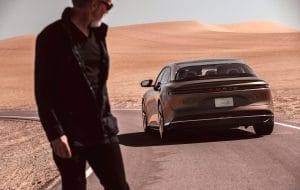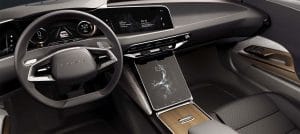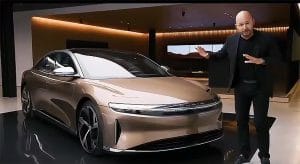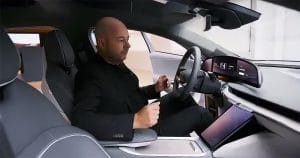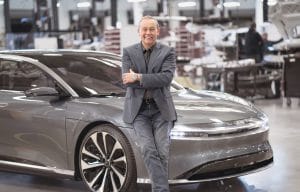
Lucid Motors CEO Peter Rawlinson said the company is driven to make the electric car industry better.
Blindingly fast, stylish and unexpectedly roomy, with a range of at least 20% more than any new battery-electric vehicle on the market, the new Lucid Air appears to have a lot going for it. But is it the first all-electric model that might finally pose a serious challenge to market leader Tesla?
That’s one of the big questions raised by the debut of the California startup’s first BEV Wednesday evening. Of course, things might look good on paper, Lucid CEO Peter Rawlinson told TheDetroitBureau.com in an exclusive interview. The question is what happens when the Lucid Air actually comes to market next year.
“Lucid Motors is driven to make the electric car better, and by doing so, help move the entire industry forward, towards accelerated adoption of sustainable mobility,” Rawlinson said as the covers over the production version of the Air were pulled back.
(Lucid Air aims to blow away the competition — at least on the dragstrip.)
Among the most significant details revealed on Wednesday: there will be four initial versions of the Air, with prices ranging from “below $80,000” to $169,000 before options and delivery fees – and prior to factoring in the federal $7,500 tax credit. Those numbers run slightly higher than comparable Tesla Model S sedans.
The automaker has been offering up a series of teasers in recent weeks and, even before the midweek reveal, but a few details have gotten final tweaks. We now know that the Air Dream Edition will be equipped with a twin-motor drivetrain producing a combined 1,080 horsepower – enough to launch it from 0 to 60 in about 2.5 seconds. Officially, it will run the quarter-mile in just 9.9 seconds, though Rawlinson told TheDetroitBureau.com he’s personally managed to beat that figure. Top speed is rated at 168 mph.
There will be three other versions of the sedan, though specs for the base Lucid Air haven’t yet been released. The step-up, the Touring model, will punch out 620 hp, hit 60 in a still impressive 3.2 seconds, run the quarter-mile in 11.4 seconds, and top out at 155 mph.
In a backgrounder, Rawlinson revealed that the Dream Edition won’t be the Air extreme machine for long. Where it features a two-motor combination, one on each axle, a GT version is in the works. It will slide two separate motors in on the rear axle, pushing maximum output up to around 1,300 horsepower.
The Dream Edition will outperform the top version of the Tesla Model S with the performance package. Lucid expects the GT model to outperform the Model S Maximum Plaid package Tesla is now working up.
There was a time when battery-cars were supposed to trade performance for range. The Air delivers both. While EPA numbers haven’t been finalized, they are expected to run from 406 miles on the Touring model up to 517 for the Grand Touring – compared to 402 miles for the latest long-range version of the Model S. The Dream Edition will get either 465 or 503 miles, depending upon configuration, according to Lucid, still well ahead of Tesla.
Rawlinson, who was previously the chief engineer for Lucid’s archrival, said his goal with Air was to focus on “smart” range, pushing for maximum efficiency through things like aerodynamics and improvements to the battery and vehicle electronics. One example is the powertrain unit which includes motor, transmission, inverter and other components yet is small enough to fit into an airline overhead luggage compartment.
As a result, the CEO claims, the Air gets about 14% more range out of a given amount of batteries. The biggest, that’s how a 110 kilowatt-hour battery yields up to 517 miles compared to 402 for the 100 kWh pack in the Model S.
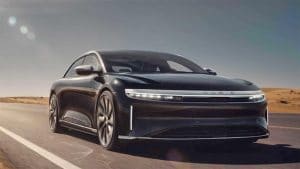
Lucid executives claim that their first expected product, the Air, will travel 517 miles on a single charge.
The efficiency is actually better than what Rawlinson expected. The original plan for the Air called for a 130 kWh battery to manage just 400 miles.
There’s another big plus, at least according to Lucid, that could help win over battery-car skeptics: charging speed. The Air’s electric architecture will operate at 900 volts, the highest in the business – Porsche setting the previous record with the 800-volt Taycan technology. That, in turn, will allow all versions of the Lucid Air to add as much as 300 miles of additional range in just 20 minutes using the latest, 350-kilowatt public quick chargers. While not quite as fast as filling up a gas tank, it’s the closest an EV has yet come.
And the Air will feature a built-in high-power charger to significantly reduce home charging times, as well.
(Lucid Air to offer biggest battery pack of any EV — and longest range.)
The design of the vehicle, as one would expect, is low and sleek, with an emphasis on aerodynamics.The design is simple, with relatively few sharp lines, a single crease running down its side.

The Lucid Air runs on a 900-volt system compared with the 800-volt model used by the Porsche Taycan.
From up front, the distinctive light blade, with its “micro-lens” headlamps, serves as the most distinctive feature, with no traditional grill since there’s relatively need for air to flow under the hood. From the rear, there’s a single, blade-like taillight assembly – which Lucid claims is the largest ever seen.
The Air is the first of what could be an array of products to come from Lucid during the coming years, work already well underway on a SUV that will share the same platform, with smaller, more affordable products to follow, according to Rawlinson.
While some have questioned why the automaker started out with a sedan in a market where utility vehicles now dominate, Lucid officials said that they wanted a halo vehicle that could establish the brand image – much as the S-Class does for Mercedes-Benz.
And, that said, potential customers will find there is plenty of room inside the sedan, starting with a “frunk” more than twice as big as any competitor’s. All told, there’s a total of 26.1 cubic feet, 16.2 cf in a conventional trunk and another 9.9 cf where a conventional gas engine would have gone.
That is, by the way, more than double the 4.8 cf size of the Mustang Mach-E’s frunk – and that SUV will lose its front storage space entirely with the Mach-E GT model. Tesla’s Model S offers 5.3 cf in its rear-wheel-drive trim, even less in the all-wheel-drive configuration.
Like Tesla – and pretty much every EV competitor – Lucid has opted for a skateboard-like platform where batteries, electronics and motors are mounted mostly below the load floor. The Air, though slightly smaller than the Model S offers a bit more interior space, in line with a domestic airline’s first class seating. There are optional rear “lounge seats” that can fold to near flat.
The skateboard platform creates “a huge opportunity to take a real benefit from the miniaturization of the components on one hand, and how you lay those out and then how much space we get out of a given vehicle size,” explained design chief Derek Jenkins.
As one would expect, the Lucid Air adopts a high-tech interior, albeit one with a minimalist feel. The cabin is dominated by a single, 34-inch curved display that runs nearly the entire width of the instrument panel.
A second display flows from center console into center stack and handles virtually all key vehicle functions, as does Tesla’s laptop-sized display. That second display can be retracted into the IP to reveal a large storage area.
The Air will initially offer a wide array of digital features, from its onboard infotainment system to its advanced driver assistance systems. The audio system, developed in-house, features 21 speakers and 800 watts. But Lucid has significant plans beyond. The fact that there is a LIDAR – or 3D, high-definition laser – sensor in Air’s nose is an indication of what’s coming. The automaker is planning to release an update that will offer true hands-free autonomy in the next few years.
More immediately, a smartphone app will serve as an alternative to a traditional key.
How well the Lucid Air will play out is far from certain. But the start-up has so far made out better than a number of other Tesla wannabes, such as Faraday Future, that have struggled or failed entirely. The test will come next year when Lucid’s new Phoenix plant is scheduled to begin production.
Initial reactions have been solid, however.
“Amidst the sea of recent EV truck announcements, it’s nearly refreshing to be introduced to a sports car that might finally rival the Tesla Model S,” said Jessica Caldwell, lead analyst with Edmunds.
“Of course that has been said several times before, but between the company’s very wealthy backers and a leader who worked on the Model S himself, Lucid might finally bring the pedigree required to challenge Elon Musk and team.”
(Lucid working up second model – even as it announces potential record-setting charging times.)
Plans call for modest sales levels, likely under 10,000, in 2021, with the Dream Edition launching next spring, the Air Grand Touring to follow mid-year, and the Touring model in late-2021. The base Air won’t reach market until 2022, with the high-performance model set to arrive around that point.

